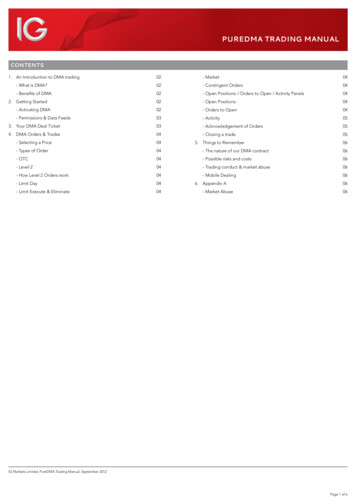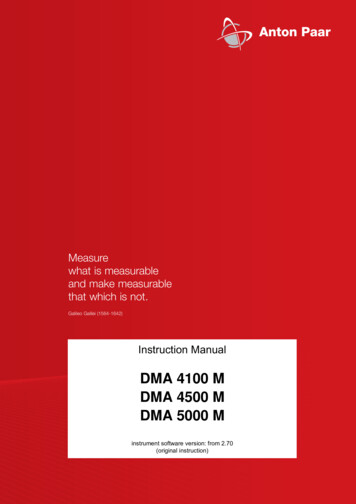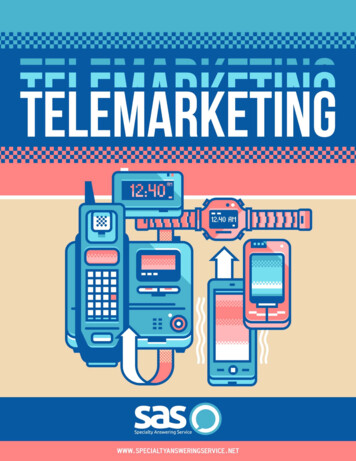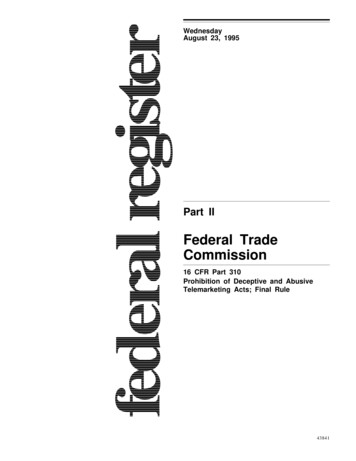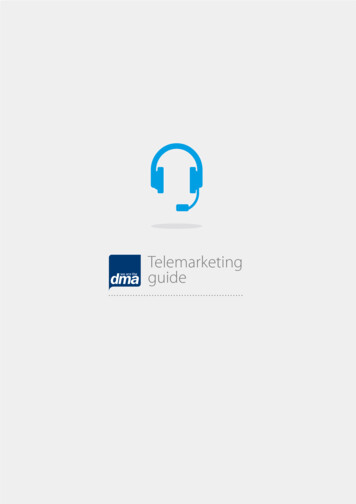
Transcription
Telemarketingguide
ContentsAcknowledgements 6Introduction 7Business practiceCompliance 9Regulation, compliance and standards 9Regulatory enforcement 9Industry standards 9Taking payments over the phone 10Verification 10Verifiers 11Quality assurance Quality assurance tools Complaints procedure 111114Complaint-handling objectives 14Complaints policy 14Complaints process 15Complaints reporting 16Complaints analysis 16Complaint-handling training 17Difficult customers 18Inclusivity and vulnerable consumers 18Corporate and social responsibility 19Setting standards 19Environment 20Workplace inclusivity 21Human resources 22Key principles 22Roles 22Recruitment 22Contracts 23Remuneration 24Training 25Supervision and support of agents 27Campaign training 27Ongoing competency 28Note for agents 292
ContentsCampaign creationCampaign strategy 31Effective outbound calling 31Key principles 31Campaign objectives 32Goal-setting 32Key tips 34Brand value 35Campaign planning 36Brief your front-line staff 36Call and after-call process 371. Disclosure 372. Structure 373. Summary 384. Post-call process 38Data 39Further information 39Sourcing data 39Handling data 41Using data 43Quality management 47Campaign deliveryConversion rates 47Customer satisfaction 47Call scheduling 49Key considerations 49Reasonable hours 49B2B call scheduling 49Ring time 50Call retrying 51Retry handling 51Nuisance calls 51Call-backs 52Call abandonment 53Abandoned call handling 53Abandoned call information message 533
ContentsTechnology and testing 54Dialler operations 54Predictive dialling 55Answer machine detection (AMD) 58International telemarketing 59Compliance 59Language 60Accents 60Cultural support 61International calling times 61Inbound sales calls 62Attracting and converting inbound prospect calls 62Handling inbound calls 62Nurturing and retaining customers 63Conversation continuity 64Call recording 64Call cost 65Customer identification 65Call content 65Interactive Voice Response (IVR) routing 66Once call is answered by a live agent 67Call duration 67Call quality 67Response/service levels 68Opening hours 69Inbound business continuity 69Outsourcing contact centres and telemarketing (CCT) 70Scope of this guidance 70Why outsource? 70Is outsourcing right for you? 72Contact centre and telemarketing (CCT) outsourcing decision card 73Choosing a CCT 74Supplier/client relationship and responsibilities Successful relationship attributes 7979Governance 80Compliance 82Data ownership 84Exit strategy 844
ContentsOutsourced campaign delivery 85Agreeing CCT campaign objectives 85SLAs and KPIs 85Outsourcing international campaigns Centralise or de-centralise? 8787Campaign responseResults and ROI 90Campaign monitoring 90Measuring campaign performance 91GlossaryGlossary 935
AcknowledgementsAcknowledgementsThe DMA wishes to thank the following members for their contribution to these guidelines:Jurgen Bolz, Genworth FinancialPeter Gale, Data Base Factory UK LtdRufus Grig, CallMediaElaine Lee, ReynoldsBusbyLee LtdSureya Landini, Blue Donkey LtdDave Nicholls, DJN Solutions LtdTrevor RicherGraham SmithSteve Smith, Brookmead Consulting LtdLuke Talbot, CallMediaJoanne Webber, npowerFiona Whelan, CPM InternationalJo Varey, Granby MarketingThe DMA wishes to thank the following for their contributions to the September 2009, first edition of these guidelines:Christine BryantRichard WebsterRob DentonRoland SmithRoxzanne BlandPam GregoryPaul NewmanVicki ShawAll rights reserved The Direct Marketing Association (UK) Limited 2014No part of this publication may be reproduced without the written permission of The Direct Marketing Association(UK) Limited6
IntroductionIntroductionRelevant and personalisedTelemarketing, when done well, can be a brilliantly successful, profitable and mutually beneficial channel ofcommunication and sales between you and your customer.It gives you an invaluable opportunity to communicate a highly relevant and personalised offer to your customer orsupporter in a timely, sensitive manner.One-to-one phone marketing allows you to build a closer relationship with your customer in a very personal, relevantmanner – complete with instant interaction and resolution – to give them a new offer that they appreciate or helpthem get more value from a product or service that they are already using.Your best practice goalsBest practice is about much, much more than mere compliance. Instead, following these guidelines will add tangiblevalue to both your organisation, looking to prosper, and your customer, looking to benefit.As with all one-to-one marketing, your main goal must always be to do the right thing for your customer – to put yourcustomer first.Only by doing this will you enjoy the fullest rewards of telemarketing – and continue to enjoy the freedom to engagewith your customer by telephone in the future.Getting it rightThe sign of a great telemarketing call is that your customer would not describe it as telemarketing – but would insteaddescribe it as a great service call!Following these guidelines will most certainly help you to achieve this goal.7
Business practice
Business practiceComplianceRegulation, compliance and standardsThere are many regulations and standards affecting contact centres. They can be split into four strands: Legislative requirements Data Protection Act 1998 Privacy and Electronic Communications Regulations 2003 Telecommunications (Lawful Business Practice) Interception of Communications Regulations 2000Regulatory organisationsCompliance with your legal obligations is adjudicated and enforced by several authorities:OfcomOfcom is the regulator for the UK communications industries, with responsibilities across television, radio,telecommunications and wireless communications services.www.ofcom.org.uk/The Information Commissioner’s Office (ICO)The ICO responds to any complaints or concerns regarding data protection and privacy issues.ico.org.uk/The Financial Conduct Authority (FCA)The FCA regulates the financial services industry in the UK, with the aim to protect consumers, ensure theindustry remains stable and promote healthy competition between financial services providers.www.fca.org.uk/The penalties for non-compliance include fines, sanctions, public censure and reputational damage.For more information on penalties – including examples of organisations that have been sanctioned – visit the ICO:ico.org.ukIndustry codesAlthough these are not law, contact centres are expected or required to comply with industry codes and standards,certainly if they are members of industry organisations.Telemarketing is subject to code requirements from the following industry bodies:The DMA CodeDMA members must comply with the provisions of the DM Code.Non–members are strongly advised to comply with the Code as it is a useful summary of the legal and bestpractice requirements for one-to-one marketers.The Code is adjudicated by the Direct Marketing Commission (DMC).The CAP CodeThe British Code of Advertising, Sales Promotion and Direct Marketing (CAP Code), which is enforced by the9
Business practiceAdvertising Standards Authority (ASA).PhonepayPlusRegarding premium rate services and charging. Mobile marketers must comply with the Code of Practice andGuidelines issued by PhonepayPlus.Industry bodies monitor compliance with their codes of practice and can impose sanctions if they are not met.Best practice guidelines and kitemarks such as those contained in this document aim to raise standards and retaincustomer confidence in the medium. They aim to ensure the long-term sustainability of our industry. Comply with relevant standardsContact centres need to decide the standards with which they will comply (in addition to those that are alegal requirement) and put in place quality assurance processes that verify they are being met. Obtain verificationRegulatory requirements and industry standards usually require verification to those bodies responsible for them.A level of transparency is necessary to comply. Encourage internal transparencyIt is also worth considering transparency internally for management and agents. This will drive standards asobjectives are set and improvements are considered by all involved.Taking payments over the phone Comply with PCIIf you accept credit card payments, you must comply with the Payment Card Industry (PCI) Security Councilstandards. Approach payment compliance as a business benefitCompliance with data security standards can bring major benefits to your organisation – while failure to complycan have serious and long-term negative consequences.Major benefits: Compliance with the PCI DSS means your systems are secure, and customers can trust you with theirsensitive payment card information Compliance improves your reputation with acquirers and payment brands -- the partners you need inorder to do business Compliance is an ongoing process, not a one-time event. It helps prevent security breaches and theftof payment card data – now and in the futureNegative consequences: Just one incident can severely damage your reputation and your ability to conduct businesseffectively, far into the future Account data breaches can lead to catastrophic loss of sales, relationships and standing in yourcommunity – and can depress share price if yours is a public company Lawsuits, Insurance claims, cancelled accounts, payment card issuer fines and government fines Client is responsible for ensuring complianceIf you have outsourced your telesales function, legal responsibility still falls on you, not your supplier, to ensurethat payments are being handled in a compliant way.10
Business practiceVerificationInclude a verification process to monitor your compliance alongside evolving regulation and standards. Assign internal responsibilityAppoint an employee to manage this process and ‘own’ regulation, compliance and standardsverification for your organisation.The employee appointed to fulfil this task will need to liaise with outside regulatory bodies. Appoint compliance officerAppoint a compliance officer and communicate their responsibilities across your organisation.Your compliance officer should be an expert in this area and be able to advise your organisation on its futuredevelopment as well as the regulation, compliance and standards to which your contact centre must adhere. Demonstrate complianceUse your verification process to monitor and improve the processes that are necessary for compliance.Keep relevant records to demonstrate compliance. Create campaign quality assuranceEnsure that all relevant personnel understand these verification processes.Create quality assurance procedures and measures to ensure compliance at the start of each campaign. Keep recordsKeep verification records including: Agent and team objectives Dialler compliance reports Copy of agent script for campaign Agent training manual for campaign Campaign results Campaign execution rules – including dialling times, retry counts, abandoned callmessage handling and so on ‘Do not call’ (DNC) list management processes Data management process Details of other front office and back office processes Complaints and resolutionsVerifiers Use a verifierConsider using a verifier for certain processes.The purpose of a verifier is to check data, a call or a transaction on an individual basis to ensure it is correct.This is a double-checked approach that you should adopt for sensitive sales and regulated productssuch as financial services.This approach minimises product cancellations, poor agent selling techniques and incorrect data.11
Business practiceQuality assuranceQuality assurance underlies all sections of your best practice. It is the responsibility of every campaign owner andcontact centre to consider and deliver quality to their customers.Without quality assurance, it is likely that the outbound telemarketing and teleservice industry will fall into disrepute– making it no longer effective as a business practice and possibly attracting direct government regulation.This section highlights quality assurance best practice that you should implement. There are also other suggestionsthat will enhance quality and will become practical in the future.Quality assurance toolsThere are a number of technological tools that provide an aid to quality assurance.Some of these, such as call recording, are fundamental to quality assurance. Others, like speech analytics, areones you should understand for the future.Call recording and quality monitoringEffective monitoring and occasional recording are commonplace with all types of calling activity. Set clear monitoring objectivesThere are four basic reasons why you and, if relevant, your outsource CCT would want to listen to recorded calls: Improve performance – for example, testing and optimising scripts Ensure quality control standards and compliance Training of both new and existing staff Crime detection Be compliantCall recording is a requirement of a number of regulatory bodies and is legally allowed – but you must meet therequirements of The Telecommunications (Lawful Business Practice) Interception of CommunicationsRegulations 2000. Tell customers and staff when calls are being recordedAlthough it is not a legal requirement to inform customers that calls are recorded, it is certainly best practice to do so.It is, however, a legal requirement to make reasonable efforts to inform all your staff that calls are beingrecorded. It is certainly best practice to ensure all staff are aware that calls they make may be recorded.This includes telemarketing staff at your company, as well as at your outsource CCT.This is a requirement of The Telecommunications (Lawful Business Practice) (Interception of Communications)Regulations 2000. Store recordingsEnsure that recordings are securely stored with accurate, detailed information – and can be easily accessed andexamined in any customer disputes. Monitor constructivelyUse quality monitoring positively – with supervisors proactively assessing a sample of calls against your criteriaand looking for constructive ways to help the campaign (or individual agents) get better results. Use screen captureUse screen capture to complement call recording. Replay both at the same time to gain a full view of youragent’s process and check that data capture is consistently high.12
Business practice Define specific training for each agentUse the findings to target specific training for each of your agents. Ensure that you quickly spot andaddress any quality issues. Recording of payment detailsThere has been some confusion about the storage of cardholder information in call recording systems.The DMA has produced a document outlining some of the requirements of the PCI DSS in relation to the storageof cardholder information in call recording systems and some potential solutions for CCT operators.You can downloaded this specific guidance here:www.dma.org.uk/uploads/PCI%20Guidance%20Notes 542ec328e8176.pdfReporting and business intelligenceTechnology can provide reporting on a wide range of measures. Some of these are fundamental to verificationby regulatory authorities. For example, under Ofcom regulations the operations of any predictive dialler mustbe captured and stored. Monitor against campaign measuresAssess calls against your campaign measures, such as conversion rate or customer satisfaction indexes,as part of a balanced scorecard to improve quality. Monitor for potential problemsA number of quality monitoring solutions can spot other potential problems in calls, including: Long silences in calls Where the agent and customer talk over each other High levels of stress in a voiceSpeech analyticsSpeech analytics is a very new technology but it will become commonplace in the future and will profoundly affect theway contact centres assess performance. It allows the identification of key words, phrases and stress patterns.Speech analytics automatically maps call information into language patterns that are based on dozens of indicatorssuch as customer satisfaction, agent politeness, acoustic stress, and call tempo. Identify call issuesUse speech analytics to uncover patterns that are quite unexpected, alerting you to issues that you would notbe able to discover otherwise. Combine with call dataCombine speech patterns with call data to reveal in-depth information and allow you to make further analysis.‘Pull’ calls individually and inspect them for quality. Monitor for swear-wordsMonitor for inappropriate language, including swear-words or other offensive terms. Investigate benefits and issuesInvestigate and assess all factors around how your specific organisation can benefit from speech analytics, including: Management of the technology Use of alerts and trends Feeding back results Using results to improve quality Legality and regularity compliance13
Business practiceComplaints procedureComplaint-handling objectivesA complaint is any expression of dissatisfaction – whether oral or written and whether justified or not.Good complaint handling is critical to the success of your relationship with your customer.It will cost you much more to replace a dissatisfied customer than to retain an existing customer – so make every effortto ensure that you have effective organisational structures in place to handle complaints. Put your customer first and value your reputationDesign your complaints management process to: Foster a positive relationship with your customer – especially when they are starting from a point ofdissatisfaction Minimise any risk or cause for anxiety for your customer Minimise any reputational damage by acting quickly, sensitively, constructively and decisively Bolster your brand reputation through excellent customer service Turn a negative experience into a positive brand story Ensure a robust clear framework that provides: Transparent, visible procedures Easy and free access – including removing all barriers and offering free phone numbers Effective and easy complaint recording methods Fair and respectful treatment of all customers Consistent processes for determining outcomes Clear timeframes and deadlines for resolving the majority of complaints Clear processing of complex complaints Full information and expectation management for your customer throughout the processComplaints policyYour complaints policy should cover the following issues: Obligation to have a written complaints policyAs a requirement of the DMA Telemarketing Manifesto, any contact centre that undertakes outbound callingactivity – whether outsourced or in-house – is required to have a written complaints policy. Obligation to deal with complaintsYour company has a duty to improve your customer’s experience of an outbound telemarketing call by fullyunderstanding the root cause of any dissatisfaction. Identify systematic issuesAs a company, you are required to manage and analyse complaints stemming from outbound calling and must: Identify systemic issues Remedy them14
Business practice Make root-cause analysis of the reasons for the complaint Change processes and procedures to minimise customer dissatisfaction Train complaint-handling staffMake sure your complaint-handling staff are knowledgeable, trained, respectful and supported by specialistsupervisors so that they are able to have empathetic and productive conversations with your complainant. Turn complaints into an opportunityWell-trained staff will help your customer feel confident that their complaint has been respected and that theyare valued by your organisation – in fact, a well-handled complaint can actually improve customer loyalty. Use complaints to gain valuable insightAlthough unwelcome on the surface, complaints can give you hugely valuable insights into how you cancontinuous improve your customer’s experience and remain competitive.Complaints process Be professional Listen to your customer and acknowledge their complaint Respond quickly, honestly and appropriately to issues they raise Collect required informationYour organisation is required to have its own written complaints procedure.As a minimum you should collect the following information: Date of complaint Reason for complaint Outcome If complaint was escalated Tracking back to agent/campaign If complaint was handled within service level agreement (SLA) Date complaint settled Categorise complaintYou should categorise each complaint as either: A complaint that can be answered and resolved immediately on the call by your agent A complaint that requires further investigation Provide information to complainantIf a complaint cannot be immediately resolved, you must provide your complainant with the following information: Acknowledgement of receipt of their complaint Details of your organisation’s complaints procedure Named contact within your organisation to handle their complaint Telephone number for this contact Your organisation’s business hours A timeline of your investigation process, to inform your customer’s expectations Details of when you expect your investigation to be completed15
Business practice Notify when complaint cannot be settled within seven daysIf your customer’s complaint cannot be settled within a seven-day period, contact them with: Notice by telephone, letter or email to advise the reason for your delay An updated timeline in which you expect to conclude the matter Explain escalation policyIn the event of your customer remaining dissatisfied, explain your organisation’s escalation procedure courteouslyand guide them through it.Complaints reporting Document full complaint procedureProvide your agent with clear, documented information on when, how and to whom to escalate a complaint –together with a clear expectation on how long a complaint will take to resolve. Log all complaint communicationsAs a minimum, log all complaints and conversations so that all communications are tracked and followed up inaccordance with your procedures.Show your agent where complaints are stored and what information is required for analysis purposes. Keep agents informedIt is essential to regularly update your call-handling teams about any existing complaints. Align process with policiesAlign your escalation process with your organisation’s complaints policy. Manage customer expectationsMake sure your agent is able to help manage your customer’s expectations by providing a timeline atthe point at which they make their complaint. Create dedicated handling for group complaintsSet up a dedicated complaints line, using live operators, in circumstances where a large number of customersmay complain.Ensure that your operators can classify the nature of each complaint and, if they are unable to resolve itthemselves, are able to connect your customer to the most relevant person or department.Ensure that someone from the appropriate department is always available to take the call.Complaints analysis Identify long-term trendsSpot trends and implement improvements by building up complaints records over time, including: Reasons for complaints How complaints are managed How many complaints are resolved at point of call React quickly to problemsIdentify trends within your complaints in order to tackle underlying issues.For instance, you may find that a particular data batch caused more complaints than others and can changeyour data strategy and stop buying data with this customer profile.16
Business practice Turn findings into trainingTurn findings into vital training to help your supervisors have constructive conversations with yourfrontline agents and, in turn, enable your agents to offer a better customer experience.Give your supervisors the time to support your agents through call monitoring and regularcompetency testing.Complaint-handling trainingYour must train your entire customer-facing staff to be able to handle complaints appropriately and positively. Key areas for trainingAs a minimum, this training should include: Complaint identification Complaints recording – accuracy of this recording Complaints resolution – handling difficult customers Regular organisation briefings and updates Understanding TPS and/or CTPS and their requirements Overcoming ‘the right to call’ – explaining to your customer where you got their data from Complaints procedure Complaint recording Escalation process Train all customer-facing staffBefore having conversations with customers, ALL your front-line staff should attend training on complaint resolutionto help them recognise dissatisfaction and be able to resolve the complaint through polite and respectful dialogue. Provide empathy trainingEmpathy should be a key part of your staff training programme. If your agent does not understand orconvey the right attitude or tone, there is a real danger that your customer’s dissatisfaction will not berecognised and will be escalated. Train staff to recognise a complaintMake sure your agent has the knowledge and the confidence not only to recognise a complaint, but also toacknowledge this in a proactive manner.A complaint can often be effectively ignored as your agent continues with their own commercial objective –brushing the complaint off instead of appropriately acknowledging and responding to your customer’s concern.An appropriate response to the complaint can often allow both your agent and your customer to relax andmove on through the call. Prepare helpful scriptsEquip your customer-facing staff with precise, pre-prepared scripts or factual responses to help answer yourcustomer’s anxieties and diffuse any potentially heated conversations. Background/knowledge trainingGive your agents the following knowledge to help them handle complaints confidently and appropriately: Educate about TPS and CTPSEnsure your agent understands how the TPS and CTPS work – and how to respond appropriately ifyour customer has registered for either service, including asking appropriate questions such as “May Iask when you signed up for this service?”.17
Business practice Provide original data sourceIf warm calling, make sure your agent is able to explain to your customer where their data wasobtained from – for example, during a previous enquiry. Full project briefingMake sure that your agent can explain to your customer why they are being called. This will helpreassure your customer, clarify that the call is relevant to them and make them more likely to listen towhat your agent has to say. Teach the DMA Telemarketing ManifestoEnsure your agent knows, understands and abides by the DMA Telemarketing Manifesto so that theycan serve your customer correctly and effectively.Difficult customers Define unacceptable customer conductCreate a written policy to define inappropriate behaviour from your customers – covering complaints, offensiveor aggressive behaviour and discrimination, such as sexist or racist remarks. Train agents to handle difficult customersMake sure your agents understand clearly what is and what is not acceptable behaviour from a customer andhow to handle such situations.Inclusivity and vulnerable consumers Have written ‘vulnerable consumers’ policyYou must have a written procedure, included in your training manual, to offer your staff guidance when dealingwith vulnerable consumers, including: Older people People who speak English as a second language Children and young people People with mental illness People with learning disabilities People with physical disabilities People with alcohol or drug use problems Develop inclusion objectivesDevelop measurable, customer-centric objectives to enable effective communication with all groups ofcustomers. Train your agents to respond to all customer types. Strategise handling of different communication needsMake provision to ensure an easy flow of two-way information for as many of your customers as possible.Develop a sensitive communication strategy, capable of engaging with disadvantaged groups via sensitive andresponsive telephone discussion in an appropriate way.For example: Avoid the temptation to just speak louder in reaction to someone who does not speak English well Instead, avoid using metaphors or phrases that might confuse, such as ‘second to none’ Speak at a steady pace using standard, non-embellished, clearly-enunciated language18
Business practice Have responsible policies in placeAccept that we all have a responsibility to protect the interests of the vulnerable and consider additionalsafeguarding steps, such as a longer cooling-off period, or a policy of confirming every transaction by post. Offer no-quibble refundsOffer no-quibble refunds or cancellation to any customer believed to be vulnerable. Be extra vigilant for customers with mental illnessWith consumers suffering mental illness, such as Alzheimer’s disease, it is not always possible to detect orrespond to vulnerabilities, particularly towards comprehension.Consumers may suffer with episodes of confusion and may therefore agree to something they do not want or need.Train your agents to recognise any signs that a customer may be vulnerable and to react appropriately. Make appropriate allowances for the hearing-impairedSometimes your customers will be using certain sensory assistance services – for example, if they have impaired hearing.These will impact on your call but can easily be accommodated by varying your speed and tone of speech.You must make Type Talk or similar transcription facilities available prior to beginning a campaign if your agentsmight regularly contact the hearing-impaired. Record vulnerable consumers’ needsAnnotate your records to flag up vulnerable consumers and their particular requirements.Ensure your agent is aware of any known special requirements and has taken appropriate action before the call.Corporate and social
International telemarketing 59 Compliance 59 Language 60 Accents 60 . International calling times 61 Inbound sales calls 62 Attracting and converting inbound prospect calls 62 Handling inbound calls 62 Nurturing and retaining customers 63 Conversation continuity 64 . Sales Promotion and Direct Marketing (CAP Code), which is enforced by the .

